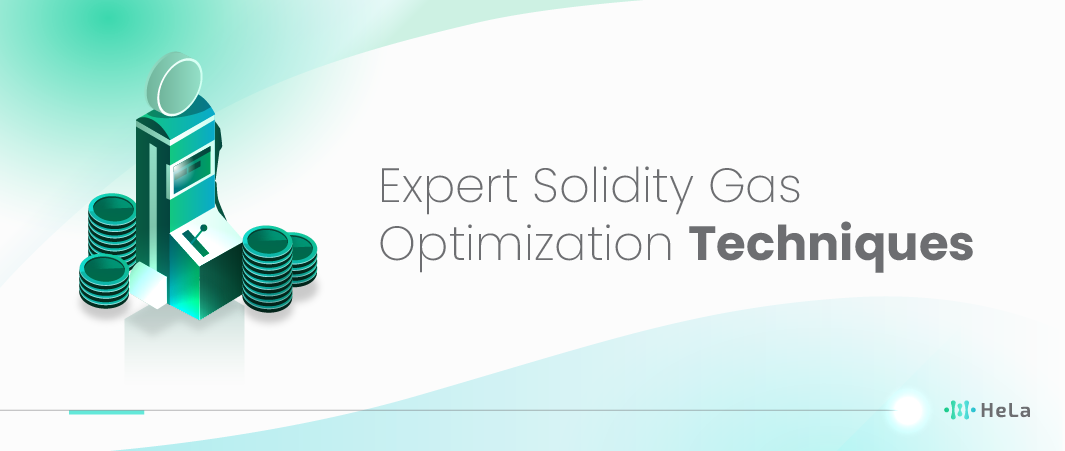In the rapidly evolving world of blockchain technology, efficiency and cost-effectiveness are paramount. For developers working with Ethereum, one critical aspect that demands attention is gas optimization in Solidity smart contracts. As the backbone of decentralized applications, Solidity contracts must be designed to minimize gas consumption, ensuring transactions are both fast and economical. This article delves into twelve expert techniques for gas optimization in Solidity, offering insights that will be invaluable in 2024 and beyond.
With the growing complexity of decentralized applications, the cost of executing smart contracts can quickly add up. Gas, the unit that measures computational effort in Ethereum, directly impacts transaction fees. Optimizing gas usage not only reduces costs but also enhances the performance and scalability of applications. As developers strive to create more efficient and robust solutions, mastering gas optimization becomes essential.
In this comprehensive guide, we will explore twelve advanced techniques to optimize gas usage in Solidity. Additionally, we will cover related topics such as common mistakes in gas management, tools and resources for optimization, and future trends in the field. Whether you are a seasoned developer or just starting your journey with Ethereum, this article will equip you with the knowledge to build more efficient smart contracts.
What is Gas in Solidity?

Gas in Ethereum serves as the fuel for executing operations within the Ethereum Virtual Machine (EVM). Every action performed by a smart contract, from simple computations to more complex operations, requires a certain amount of gas. This mechanism ensures that resources are allocated fairly and prevents malicious actors from spamming the network with resource-intensive computations.
When a user initiates a transaction, they specify a gas limit, representing the maximum amount of gas they are willing to consume for that transaction. If the transaction’s gas consumption exceeds this limit, the transaction fails, and any state changes are reverted, though the gas spent up to that point is not refunded. This makes understanding and managing gas critical for developers to ensure their smart contracts execute efficiently and cost-effectively.
Also Read: 15 Best Web3 Prediction Markets in 2024
Gas prices, denominated in gwei (a small unit of Ether), fluctuate based on network demand. During times of high congestion, gas prices can soar, making transactions more expensive. This variability underscores the need for gas optimization, as well-written contracts that minimize gas usage can save significant costs over time. Developers must be adept at writing efficient code to ensure their applications remain functional and affordable, even during periods of high network activity.
The Importance of Gas Optimization
Optimizing gas in Solidity is crucial for several reasons, particularly as the Ethereum network continues to grow and evolve. Firstly, gas optimization directly impacts the cost of deploying and executing smart contracts. With gas prices subject to market fluctuations, efficient code can lead to significant cost savings for developers and users alike. This is especially important for projects with frequent transactions or complex operations, where gas costs can quickly accumulate.
Another key benefit of gas optimization is improved performance. Efficient contracts require less computational effort, resulting in faster execution times. This can enhance the user experience, making decentralized applications (dApps) more responsive and reliable. In a competitive environment where user satisfaction is paramount, optimizing for speed and cost can set a project apart.
Moreover, gas optimization contributes to the scalability of the Ethereum network. By reducing the computational load of individual transactions, optimized contracts help alleviate network congestion. This not only benefits the specific dApp but also the broader Ethereum ecosystem by improving overall network efficiency. As Ethereum transitions to Ethereum 2.0 and beyond, the demand for scalable and efficient smart contracts will only increase.
Gas optimization in Solidity is essential for reducing costs, improving performance, and contributing to the scalability of the Ethereum network. Developers who master these techniques can create more efficient, cost-effective, and user-friendly dApps, positioning their projects for success in the rapidly evolving blockchain landscape.
12 Expert Solidity Gas Optimization Techniques to Know in 2024

In the competitive realm of Ethereum development, optimizing gas usage in Solidity smart contracts is essential for creating cost-effective and efficient decentralized applications (dApps). With gas prices fluctuating and the demand for network resources increasing, developers must be adept at minimizing gas consumption. Here, we present twelve expert techniques for gas optimization that will be invaluable for 2024 and beyond.
1. Use Fixed-Size Data Types
Fixed-size data types, such as uint256 and bytes32, are more gas-efficient than their dynamic counterparts. When writing smart contracts, always prefer fixed-size data types where applicable. For instance, using uint256 instead of uint (which is an alias for uint256) or using bytes32 instead of bytes can result in significant gas savings. This practice minimizes the overhead associated with variable-sized data types, making your contract more predictable in terms of gas costs.
2. Optimize Function Visibility
Function visibility in Solidity determines how and where functions can be called. Specifying functions as external rather than public can save gas, as external functions use less gas when called externally. On the other hand, public functions can be called both internally and externally, which incurs additional gas costs due to the extra layer of function call indirection. Evaluate your contract functions and set their visibility to external if they are not intended to be called internally.
3. Minimize Storage Reads/Writes
Storage operations are among the most expensive operations in Solidity. Each read and write to the blockchain storage consumes a significant amount of gas. To optimize, reduce the number of storage interactions by caching frequently accessed storage variables in memory. For example, instead of reading a state variable multiple times within a function, read it once into a local variable and use that local variable throughout the function. This reduces the number of expensive storage operations and can greatly improve gas efficiency.
4. Leverage calldata for Function Parameters
When dealing with function parameters, especially large arrays or data structures, use calldata instead of memory. Calldata is a non-modifiable, temporary data location that is much cheaper than memory. By passing parameters through calldata, you avoid the cost of copying data into memory, which can lead to substantial gas savings, particularly for large inputs.
5. Avoid Unnecessary Calculations
Performing calculations repeatedly can be costly in terms of gas. Precompute values that are used frequently and store them in state variables. For instance, if a value is derived from other state variables and is used in multiple places, calculate it once and store the result. This practice not only reduces gas costs but also simplifies the logic within your functions, making them easier to read and maintain.
6. Use Events for Logging
Instead of storing data on-chain for logging purposes, use events. Events are stored in transaction logs, which are much cheaper than contract storage. They also provide an efficient way to index and retrieve historical data. By relying on events for logging, you can significantly reduce the gas costs associated with data storage while still maintaining a record of important events and state changes.
7. Pack Structs and Arrays
Optimize the storage layout of structs and arrays by packing variables into fewer storage slots. Solidity packs variables that fit within a single 32-byte storage slot together. For example, placing multiple uint8 variables consecutively in a struct can result in them being stored in a single slot, rather than separate slots. This packing reduces the number of storage operations required, thereby saving gas.
8. Short-Circuit Logic
Use short-circuit evaluation in logical operations. In Solidity, logical operators such as && and || short-circuit, meaning they stop evaluating as soon as the result is determined. For example, in an if statement with if (a && b), if a is false, b will not be evaluated. This can save gas, especially if the unevaluated condition involves expensive operations or function calls.
9. Externalize Reusable Code
Move reusable code to external libraries. Solidity libraries allow you to deploy common code once and reuse it across multiple contracts. This not only reduces the size of your contracts but also saves on deployment gas costs. By externalizing reusable functions into libraries, you ensure that your contracts remain lean and cost-effective to deploy.
10. Use the require Function Wisely
Place require statements early in functions to fail fast. This practice ensures that invalid transactions are halted before consuming additional gas on subsequent operations. By validating conditions at the beginning of functions, you minimize the gas wasted on operations that will ultimately fail, making your contract more efficient and cost-effective.
11. Leverage Bitwise Operations
Bitwise operations can be more gas-efficient than their arithmetic counterparts. Operations such as AND, OR, and XOR can perform certain calculations faster and with less gas. For example, bitwise operations can be used for tasks like masking and bit manipulation, which are common in low-level programming. By incorporating bitwise operations where appropriate, you can optimize your contract’s performance and gas consumption.
12. Keep Contract Size Small
Smaller contracts are cheaper to deploy and interact with. Break down large contracts into smaller, modular contracts that can interact with each other. This modular approach not only reduces the gas costs associated with deployment but also makes your contracts easier to manage and upgrade. By keeping your contracts small and focused, you enhance both their efficiency and maintainability.
Incorporating these techniques into your Solidity development practices will help you create more efficient and cost-effective smart contracts. As the Ethereum network continues to evolve, staying updated with the latest optimization strategies will be essential for maintaining competitive and high-performing decentralized applications.
Tools and Resources for Gas Optimization

Optimizing gas consumption in Solidity can be challenging, but several tools and resources can help developers achieve more efficient smart contracts. Utilizing these tools can streamline the optimization process and provide valuable insights into gas usage.
Solidity Optimizer
The Solidity compiler includes a built-in optimizer that automatically applies various optimization techniques during compilation. To enable it, add the optimization settings in your compiler configuration file. The optimizer works by rearranging and refining the code to minimize gas usage, making it an essential tool for any Solidity developer aiming to improve contract efficiency. Regularly updating your compiler and using the latest optimization settings can yield significant gas savings.
Gas Profiler Tools
Tools like remix-gas-profiler and eth-gas-reporter provide detailed insights into gas usage within your smart contracts. These profilers help identify the most gas-intensive operations and pinpoint areas for improvement. For example, eth-gas-reporter integrates with popular testing frameworks like Mocha to generate gas usage reports, while remix-gas-profiler offers real-time gas consumption analysis within the Remix IDE. By analyzing these reports, developers can make informed decisions on where to apply optimization techniques.
Static Analysis Tools
Static analysis tools such as MythX and Slither perform comprehensive analyses of your smart contracts to detect potential gas optimization opportunities and security vulnerabilities. Slither, developed by Trail of Bits, provides in-depth analysis and recommendations for improving contract efficiency. MythX, a security analysis platform, also highlights optimization possibilities alongside its primary focus on security. Utilizing these tools ensures that your contracts are both secure and optimized for gas efficiency.
Gas Estimation in Testing
Testing frameworks like Truffle and Hardhat offer gas estimation features that allow you to simulate transactions and measure gas consumption before deploying your contracts. These estimates provide a clear picture of how much gas different functions and transactions will consume, helping you identify and optimize gas-heavy operations. Incorporating gas estimation into your testing routine ensures that your contracts are optimized for cost-effectiveness from the development stage.
Community Resources and Best Practices
Engaging with the Ethereum developer community through forums, GitHub repositories, and social media platforms can provide valuable insights and best practices for gas optimization. Platforms like Stack Exchange, the Ethereum subreddit, and GitHub repositories dedicated to Solidity development are excellent places to share knowledge and learn from the experiences of others. By participating in these communities, developers can stay updated on the latest optimization techniques and tools, ensuring their contracts remain efficient and up-to-date.
These tools and resources are indispensable for any Solidity developer looking to optimize gas usage in their smart contracts. By leveraging these technologies, developers can create more efficient, cost-effective, and high-performing decentralized applications.
Future Trends in Solidity Gas Optimization
As Ethereum evolves, the landscape of gas optimization is expected to change. Several trends and developments will shape the future of gas optimization in Solidity, providing new opportunities and challenges for developers.
Ethereum 2.0 and Layer 2 Solutions
The transition to Ethereum 2.0, along with the rise of Layer 2 scaling solutions, will significantly impact gas optimization strategies. Ethereum 2.0 aims to improve scalability and reduce gas costs through a shift to a proof-of-stake consensus mechanism and the introduction of shard chains. Layer 2 solutions, such as rollups and state channels, offer additional ways to reduce gas consumption by handling transactions off-chain while maintaining the security of the main Ethereum network. Developers will need to adapt their optimization techniques to leverage these advancements effectively.
Advanced Compiler Optimizations
The Solidity compiler continues to evolve, with ongoing improvements in optimization techniques. Future versions of the compiler are expected to introduce more advanced and automated optimizations, making it easier for developers to write gas-efficient code. These improvements will likely include better handling of complex data structures, more efficient code generation, and enhanced support for modular and reusable contract designs. Staying updated with compiler advancements will be crucial for developers aiming to maintain optimal gas efficiency.
Also Read: 12 Best Crypto Portfolio to Check this 2024
Integration of Machine Learning
Machine learning techniques are being explored to automatically detect and apply gas optimization strategies. By analyzing large datasets of smart contract code, machine learning algorithms can identify patterns and suggest optimizations that may not be immediately apparent to human developers. These advancements could revolutionize how developers approach gas optimization, providing more automated and intelligent tools for improving contract efficiency. The integration of machine learning into development workflows could lead to significant gas savings and more robust contract designs.
Enhanced Developer Tools

As the demand for gas optimization grows, new and improved developer tools will emerge. These tools will provide more precise and user-friendly ways to analyze and optimize gas consumption. Future tools may offer real-time feedback on gas usage, automated code suggestions for optimization, and seamless integration with popular development environments. By adopting these enhanced tools, developers can streamline their optimization processes and ensure their contracts are as efficient as possible.
These trends highlight the dynamic nature of Ethereum development and the importance of staying informed about the latest advancements in gas optimization. By embracing new technologies and best practices, developers can continue to create efficient, scalable, and cost-effective smart contracts.
Conclusion
In the ever-evolving world of Ethereum development, mastering gas optimization in Solidity is crucial for creating efficient and cost-effective smart contracts. By understanding the importance of gas optimization and implementing the twelve expert techniques discussed, developers can significantly reduce costs, improve performance, and contribute to the scalability of the Ethereum network.
As the Ethereum ecosystem continues to grow and innovate, staying informed about the latest trends and tools in gas optimization will be vital. Embracing new technologies and best practices will ensure that your smart contracts remain competitive and robust in the dynamic blockchain landscape.
By prioritizing gas optimization, developers not only enhance their projects but also support the broader Ethereum community in building a more efficient and scalable decentralized future. Whether you are a seasoned developer or new to the field, these insights and techniques will empower you to optimize your Solidity smart contracts effectively.
Disclaimer: The information provided by HeLa Labs in this article is intended for general informational purposes and does not reflect the company’s opinion. It is not intended as investment advice or recommendations. Readers are strongly advised to conduct their own thorough research and consult with a qualified financial advisor before making any financial decisions.

Joshua Soriano
I am a writer specializing in decentralized systems, digital assets, and Web3 innovation. I develop research-driven explainers, case studies, and thought leadership that connect blockchain infrastructure, smart contract design, and tokenization models to real-world outcomes.
My work focuses on translating complex technical concepts into clear, actionable narratives for builders, businesses, and investors, highlighting transparency, security, and operational efficiency. Each piece blends primary-source research, protocol documentation, and practitioner insights to surface what matters for adoption and risk reduction, helping teams make informed decisions with precise, accessible content.
- Joshua Soriano#molongui-disabled-link
- Joshua Soriano#molongui-disabled-link
- Joshua Soriano#molongui-disabled-link
- Joshua Soriano#molongui-disabled-link

